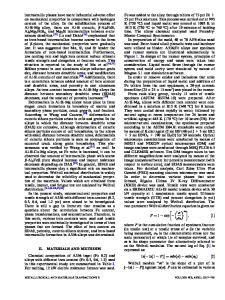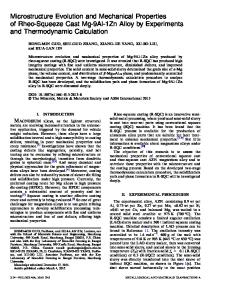Mechanical properties and microstructure of centrifugally cast alloy 718
- PDF / 4,496,225 Bytes
- 12 Pages / 594 x 774 pts Page_size
- 76 Downloads / 476 Views
I.
A L L O Y 718 is a complex, precipitation hardened, nickelbase alloy widely used for high temperature component applications. Usually, the alloy is employed as a wrought product since the mechanical properties of the cast alloy are marginal to meet the strength, creep-rupture, and fatigue crack propagation requirements. However, the use of directional solidification techniques to increase the strength and creep-rupture properties of high temperature alloys cast to shape has been well documented. ~,2The success of the directional solidification approach has suggested that the application of improved casting techniques to control solidification microstructure could produce significantly improved properties for larger cast section sizes. This paper will present the results from a study of the mechanical properties and microstructure of centrifugally cast alloy 718 produced with two separate mold speeds. The results compare favorably with similar results obtained from wrought alloy 718 and provide further insight concerning the properties of this alloy.
II.
Table I. Chemical Composition and Heat Treatment of Cast Alloy 718
INTRODUCTION
EXPERIMENTAL P R O C E D U R E S
A. Material and Heat Treatments The chemical composition of the cast alloy 718 and the heat treatment details are given in Table I. The castings were produced by a vendor in the form of fiat discs (approximately 2.54 cm thick by 25.4 cm outside diameter by 7.62 cm inside diameter) using two different mold rotation speeds, 50 and 200 rpm. The castings were given the duplex age heat treatment shown in Table I to develop the y" precipitate microstructure for increased strength. Figure 1 shows a photograph of a cast disc. D.J. MICHEL, Section Head, and H.H. SMITH, Research Metallurgist, are with Thermostructural Materials Branch, Materials Science and Technology Division, Naval Research Laboratory, Washington, DC 20375. Manuscript submitted November 20, 1984. METALLURGICAL TRANSACTIONS A
C Mn P S Si
0.056 0.010 0.0s 0.004 0.010
Composition Cr Ni Ti A1 Mo
Temperature
Time
(Weight Percent)* 19.60 Co 0.010 53.40 Fe Ba! 1.05 Cu 0.010 0.48 B 0.003 3.09 Nb/Ta 5.22 Heat Treatment
718 ~ (1325 ~ 8 h. furnace cool at 56 ~ (100 ~ per h. 621 ~ (1150 ~ 8 h. to air cool *Vendor supplied analysis
B. Specimen Preparation Specimen blanks were cut from the as-received castings either above or below the mid-plane of the discs. Tensile/creep and 0.5T CT (compact tension) fatigue crack propagation specimens were machined from the blanks in accordance with ASTM Standards E8 and E647. 3'4 The notch in the CT specimens and gage length in the tensile/creep specimens were oriented either in the radial direction or transverse to the radial direction of the castings. All of the CT specimens were precracked in accordance with ASTM Standard E6474 such that the final Kmaxduring precracking did not exceed the initial Kmax of the fatigue test.
C. Mechanical Property Evaluations The tensile, creep, and fatigue tests were conducted at 427,538, and 649 ~ (800, 1000, and 1200 ~
Data Loading...











